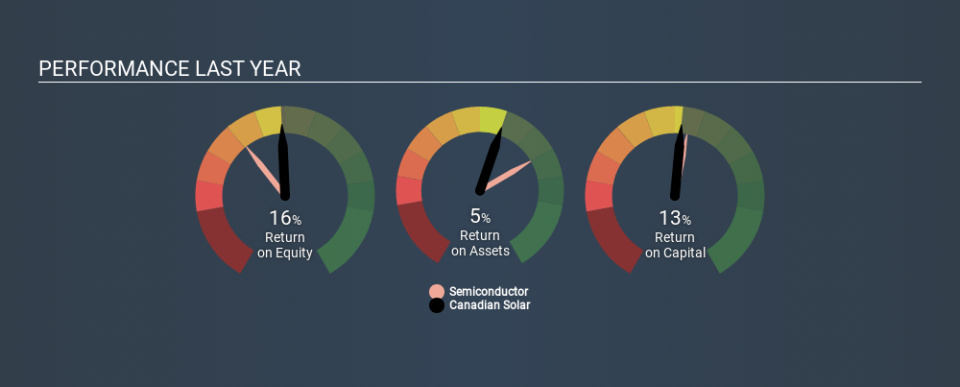Here's What Canadian Solar Inc.'s (NASDAQ:CSIQ) ROCE Can Tell Us

Today we'll evaluate Canadian Solar Inc. (NASDAQ:CSIQ) to determine whether it could have potential as an investment idea. Specifically, we'll consider its Return On Capital Employed (ROCE), since that will give us an insight into how efficiently the business can generate profits from the capital it requires.
Firstly, we'll go over how we calculate ROCE. Next, we'll compare it to others in its industry. Finally, we'll look at how its current liabilities affect its ROCE.
Return On Capital Employed (ROCE): What is it?
ROCE is a metric for evaluating how much pre-tax income (in percentage terms) a company earns on the capital invested in its business. All else being equal, a better business will have a higher ROCE. Overall, it is a valuable metric that has its flaws. Renowned investment researcher Michael Mauboussin has suggested that a high ROCE can indicate that 'one dollar invested in the company generates value of more than one dollar'.
So, How Do We Calculate ROCE?
Analysts use this formula to calculate return on capital employed:
Return on Capital Employed = Earnings Before Interest and Tax (EBIT) ÷ (Total Assets - Current Liabilities)
Or for Canadian Solar:
0.13 = US$281m ÷ (US$5.3b - US$3.1b) (Based on the trailing twelve months to September 2019.)
Therefore, Canadian Solar has an ROCE of 13%.
See our latest analysis for Canadian Solar
Is Canadian Solar's ROCE Good?
One way to assess ROCE is to compare similar companies. In our analysis, Canadian Solar's ROCE is meaningfully higher than the 9.9% average in the Semiconductor industry. We would consider this a positive, as it suggests it is using capital more effectively than other similar companies. Separate from Canadian Solar's performance relative to its industry, its ROCE in absolute terms looks satisfactory, and it may be worth researching in more depth.
The image below shows how Canadian Solar's ROCE compares to its industry, and you can click it to see more detail on its past growth.
When considering this metric, keep in mind that it is backwards looking, and not necessarily predictive. Companies in cyclical industries can be difficult to understand using ROCE, as returns typically look high during boom times, and low during busts. ROCE is only a point-in-time measure. Since the future is so important for investors, you should check out our free report on analyst forecasts for Canadian Solar.
What Are Current Liabilities, And How Do They Affect Canadian Solar's ROCE?
Current liabilities are short term bills and invoices that need to be paid in 12 months or less. Due to the way the ROCE equation works, having large bills due in the near term can make it look as though a company has less capital employed, and thus a higher ROCE than usual. To check the impact of this, we calculate if a company has high current liabilities relative to its total assets.
Canadian Solar has total liabilities of US$3.1b and total assets of US$5.3b. As a result, its current liabilities are equal to approximately 58% of its total assets. This is admittedly a high level of current liabilities, improving ROCE substantially.
The Bottom Line On Canadian Solar's ROCE
This ROCE is pretty good, but remember that it would look less impressive with fewer current liabilities. Canadian Solar shapes up well under this analysis, but it is far from the only business delivering excellent numbers . You might also want to check this free collection of companies delivering excellent earnings growth.
If you like to buy stocks alongside management, then you might just love this free list of companies. (Hint: insiders have been buying them).
If you spot an error that warrants correction, please contact the editor at editorial-team@simplywallst.com. This article by Simply Wall St is general in nature. It does not constitute a recommendation to buy or sell any stock, and does not take account of your objectives, or your financial situation. Simply Wall St has no position in the stocks mentioned.
We aim to bring you long-term focused research analysis driven by fundamental data. Note that our analysis may not factor in the latest price-sensitive company announcements or qualitative material. Thank you for reading.

 Yahoo Finance
Yahoo Finance 
